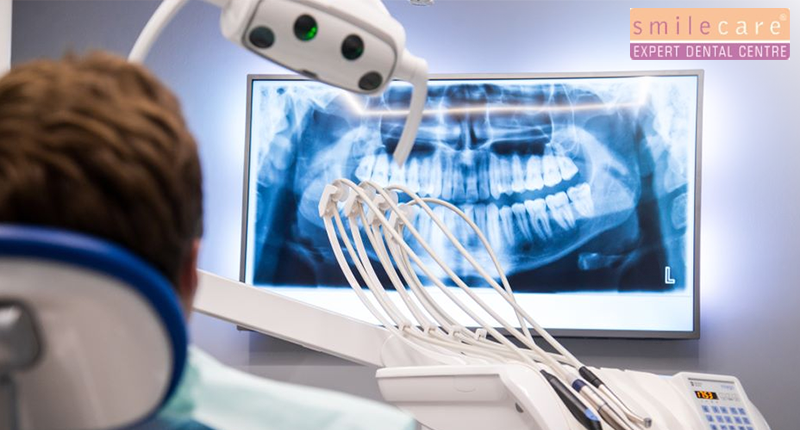Dental X-rays, or oral radiography or dental imaging, are an essential diagnostic tool used in dentistry. This comprehensive guide will give you everything you need about dental X-rays, including their importance in oral health.
Types of Dental X-Rays
- Bitewing X-Rays: These X-rays focus on the upper and lower back teeth, detecting cavities and decay between teeth.
- Periapical X-Rays: Periapical X-rays capture the entire tooth from crown to root and help assess the tooth’s overall health, including the roots and surrounding bone.
- Panoramic X-Rays: Panoramic X-rays provide a broad view of the entire mouth, allowing dentists to assess the overall dental and jaw structure.
- Cone Beam Computed Tomography (CBCT): CBCT produces three-dimensional images, enabling detailed assessment of teeth, bone, and soft tissues.
- Occlusal X-Rays: Occlusal X-rays are used to capture a broad view of the upper or lower jaw, primarily for assessing the development of teeth in children.
Uses and Benefits of Dental X-Rays
Dental X-rays serve various purposes in dental care:
- Detection of cavities and tooth decay that may not be visible during a clinical examination.
- Assessment of bone health, gum diseases, and conditions like periodontitis.
- Identification of impacted teeth, abnormal growths, and cysts.
- Preoperative planning for dental procedures such as extractions, implants, or orthodontic treatments.
Safety Precautions for Dental X-Rays
To ensure patient safety during dental X-rays, the following precautions are taken:
- Use lead aprons and thyroid collars to shield vital organs from radiation exposure.
- Strict adherence to recommended exposure settings and techniques to minimize radiation doses.
- Special considerations for pregnant patients include postponing non-essential X-rays until after delivery.
Frequency of Dental X-Rays
The frequency of dental X-rays depends on various factors, including age and individual dental health needs. General guidelines include:
- Children may require X-rays more frequently to monitor tooth development and detect potential issues.
- Adults with good oral health typically require X-rays every 1-2 years.
- Individuals with existing dental conditions or higher risk factors may need X-rays more frequently.
Interpreting Dental X-Ray Results
Understanding dental X-ray results is crucial for accurate diagnosis. Consider the following points:
- Familiarize yourself with dental anatomy as seen on x-rays, including teeth, roots, and supporting structures.
- Learn to recognize common abnormalities such as cavities, bone loss, impacted teeth, and infections.
- Consult dental professionals to interpret x-ray results and formulate appropriate treatment plans.
Advancements in Dental Radiography Technology
Recent advancements in dental radiography have improved patient care and diagnosis:
- Digital radiography eliminates the need for film processing, providing instant high-quality images with reduced radiation exposure.
- Three-dimensional imaging techniques like CBCT offer enhanced visualization and improved treatment planning.
- Modern radiography technology ensures minimal radiation exposure without compromising image quality.
Finding the Best Dental Care Professionals
Regarding root canal treatments, selecting the right dentist is crucial for successful outcomes. Here are some tips for finding the best dental care professionals:
- Research and Recommendations: Seek recommendations from friends, family, or trusted healthcare providers. Conduct online research and read reviews to gauge the reputation and expertise of potential dentists.
- Specialization and Experience: Look for dentists specializing in endodontics, which involves root canal treatments. Consider their years of experience and successful track record in performing such procedures.
- Credentials and Certifications: Ensure the dentist is licensed and has relevant certifications and affiliations with reputable dental associations.
- Technology and Techniques: Inquire about the dental clinic’s technology and techniques used for root canal treatments. Advanced equipment and updated procedures can contribute to more efficient and comfortable experiences.
- Personal Connection: Schedule a consultation or visit the dental clinic to assess the environment, staff professionalism, and the dentist’s ability to communicate and address your concerns.
When searching for the best dentist in Bandra West or a dentist in Bandra, consider the factors above to make an informed decision and receive optimal dental care.
Dental X-rays play a vital role in diagnosing and treating oral health conditions. By understanding dental X-rays’ types, benefits, and safety precautions, you can make informed decisions about your dental care and maintain optimal oral health. Stay up-to-date with advancements in dental radiography technology to ensure the best possible treatment outcomes. And remember, when it comes to specialized treatments like root canals, finding the right dental care professional is essential for successful outcomes and a positive dental experience .
Question & Answer
- What kinds of problems can be revealed in a dental X-ray?
Dental X-rays may reveal:
Abscesses or cysts.
Bone loss.
Cancerous and non-cancerous tumours.
Decay between the teeth.
Developmental abnormalities.
Poor tooth and root positions.
Problems inside a tooth or below the gum line.
2. How many dental X-rays are OK?
Dental X-rays (radiographs) are images of your teeth that your dentist uses to evaluate your oral health. These X-rays are used with low levels of radiation to capture images of the interior of your teeth and gums. These X-rays can help your dentist to identify problems like cavities, tooth decay, and impacted teeth.
3. Does the xray show gum disease?
Dental X-rays can show diseases of the mouth, including the teeth and gums, that would otherwise go undetected. These diseases include potentially serious conditions such as the following: An abscess, or infection at the root of a tooth or between the gum and a tooth.
4. Can tartar be seen on xray?
Dental X-rays are essential in helping dentists identify hidden tooth decay, plaque and tartar buildup, and potential root rot, among other things.
5. Will an xray show a failed root canal?
Can You See a Failed Root Canal on X-ray? Yes. Endodontists use X-rays to find and treat a failed root canal because it’s often hard to see any problems with the naked eye.

